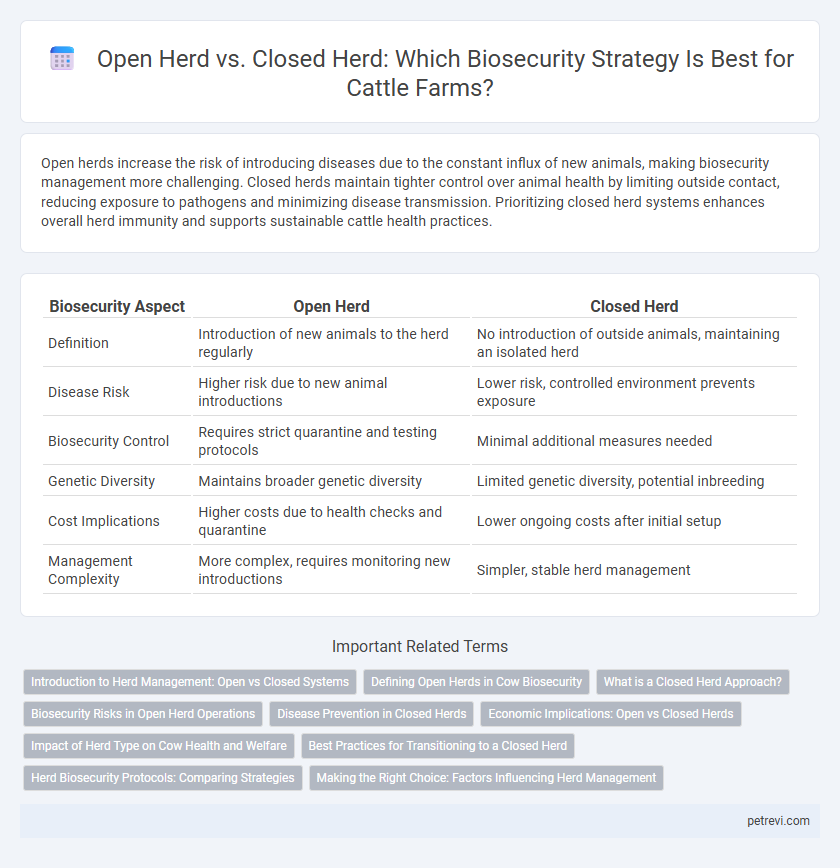Open herds increase the risk of introducing diseases due to the constant influx of new animals, making biosecurity management more challenging. Closed herds maintain tighter control over animal health by limiting outside contact, reducing exposure to pathogens and minimizing disease transmission. Prioritizing closed herd systems enhances overall herd immunity and supports sustainable cattle health practices.
Table of Comparison
| Biosecurity Aspect | Open Herd | Closed Herd |
|---|---|---|
| Definition | Introduction of new animals to the herd regularly | No introduction of outside animals, maintaining an isolated herd |
| Disease Risk | Higher risk due to new animal introductions | Lower risk, controlled environment prevents exposure |
| Biosecurity Control | Requires strict quarantine and testing protocols | Minimal additional measures needed |
| Genetic Diversity | Maintains broader genetic diversity | Limited genetic diversity, potential inbreeding |
| Cost Implications | Higher costs due to health checks and quarantine | Lower ongoing costs after initial setup |
| Management Complexity | More complex, requires monitoring new introductions | Simpler, stable herd management |
Introduction to Herd Management: Open vs Closed Systems
Open herd systems allow the introduction of new cattle, increasing genetic diversity but raising risks of disease transmission and biosecurity breaches. Closed herds maintain strict control by restricting external animal additions, minimizing pathogen entry and enhancing herd health stability. Effective biosecurity protocols in each system depend on management goals, balancing genetic improvement with disease prevention.
Defining Open Herds in Cow Biosecurity
Open herds in cow biosecurity refer to operations where new animals are regularly introduced from external sources, increasing the risk of pathogen entry and disease transmission. These herds require stringent testing and quarantine protocols to minimize exposure to infections such as bovine viral diarrhea and Johne's disease. Maintaining strict monitoring and biosecurity measures is essential to protect herd health in open herd systems.
What is a Closed Herd Approach?
A closed herd approach in cow biosecurity involves preventing the introduction of new animals into the herd, thereby minimizing the risk of infectious diseases. This strategy ensures that all cattle are born and raised within the same farm, eliminating exposure to external pathogens. Maintaining a closed herd reduces the likelihood of disease outbreaks, enhances overall herd health, and supports long-term productivity.
Biosecurity Risks in Open Herd Operations
Open herd operations increase exposure to biosecurity risks by allowing the introduction of new animals, which can carry infectious diseases like bovine viral diarrhea and Johne's disease. These risks are heightened by the constant movement of cattle between farms, making disease control and monitoring more challenging. Effective biosecurity in open herds requires rigorous testing, quarantine protocols, and strict hygiene measures to minimize pathogen transmission.
Disease Prevention in Closed Herds
Closed herds significantly enhance cow biosecurity by minimizing the risk of introducing infectious diseases through new animal introductions. By restricting animal movement and sourcing exclusively from within the herd, closed systems reduce exposure to pathogens like bovine tuberculosis and Johne's disease. Consistent health monitoring and strict quarantine protocols further bolster disease prevention efforts in closed herds.
Economic Implications: Open vs Closed Herds
Open herds often incur higher economic risks due to increased exposure to infectious diseases, leading to greater veterinary costs and potential loss of production. Closed herds, by limiting the introduction of new animals, help maintain herd health stability and reduce disease-related expenses, ultimately supporting more predictable financial outcomes. Investing in closed herd biosecurity measures enhances long-term profitability through reduced disease outbreaks and improved overall herd productivity.
Impact of Herd Type on Cow Health and Welfare
Open herds increase the risk of introducing infectious diseases such as Bovine Viral Diarrhea (BVD) and Johne's disease, resulting in compromised cow health and increased veterinary costs. Closed herds enhance biosecurity by minimizing pathogen exposure, leading to improved welfare indicators like reduced stress and higher milk production. Maintaining a closed herd system supports stable immune function and lowers mortality rates among dairy cows, contributing to overall herd resilience.
Best Practices for Transitioning to a Closed Herd
Transitioning to a closed herd significantly reduces the risk of introducing infectious diseases by eliminating the introduction of new animals from external sources. Best practices include implementing strict quarantine measures for any necessary new additions, comprehensive health screening protocols, and robust vaccination programs to maintain herd immunity. Maintaining accurate records and ongoing biosecurity training for farm personnel ensures sustained disease prevention and promotes overall herd health.
Herd Biosecurity Protocols: Comparing Strategies
Open herd biosecurity protocols involve introducing new animals into the herd, which increases the risk of disease transmission and requires stringent quarantine and testing measures to prevent outbreaks. Closed herd systems minimize biosecurity risks by restricting animal movement and maintaining stringent on-farm hygiene practices, reducing exposure to external pathogens. Comparing strategies, closed herds typically achieve higher disease control efficacy through consistent isolation, while open herds depend heavily on rigorous screening and isolation to safeguard overall herd health.
Making the Right Choice: Factors Influencing Herd Management
Open herds increase the risk of introducing infectious diseases through the purchase of new cattle, necessitating stringent quarantine and screening protocols to maintain biosecurity. Closed herds minimize external disease exposure by restricting animal movement, promoting stable herd immunity and reducing veterinary costs. Key factors influencing the choice between open and closed herds include disease prevalence in surrounding areas, herd size, and the capacity for ongoing health monitoring and biosecurity measures.
Open Herd vs Closed Herd for Cow Biosecurity Infographic

 petrevi.com
petrevi.com